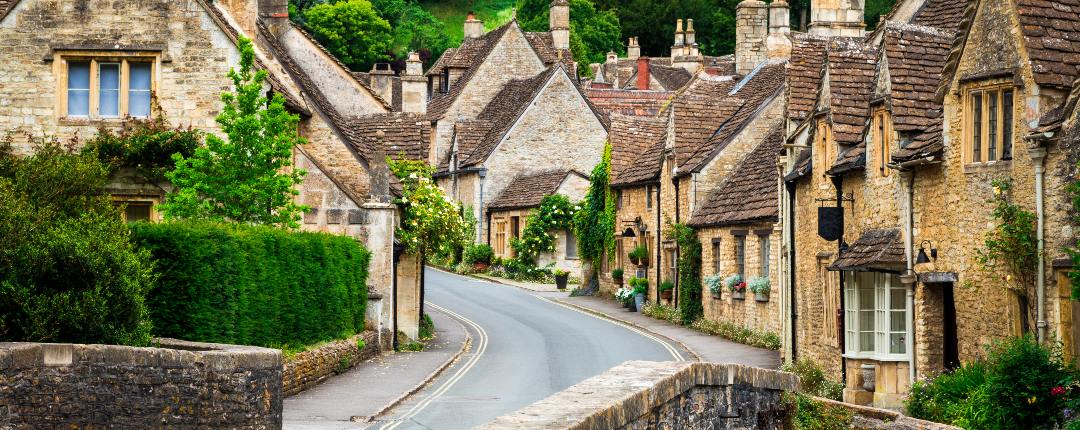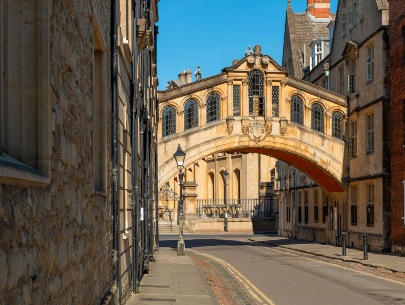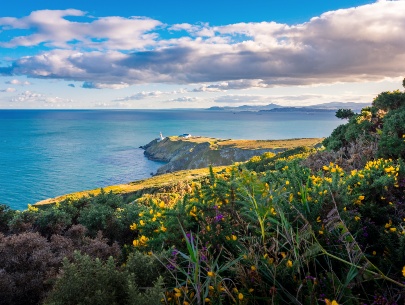The Cotswolds are located in south-west and west-central England. The largest designated Area of Outstanding Natural Beauty in the UK, it’s about 90 miles long and roughly 25 miles across, covering almost 800 square miles as noted at the start. It lies mainly in the counties of Oxfordshire and Gloucestershire but also extends into Wiltshire, Worcestershire, Somerset, and Warwickshire. Spread across lush, green hills, much of the landscape is farmland, and in the spring, there are bright yellow fields with rapeseed flowers in bloom. The River Thames and several tributaries run through, including the River Leach and River Windrush.
Stretching across nearly 800 square miles, the Cotswolds region is renowned for its postcard-perfect villages with meandering streams crossed by picturesque bridges while homes and buildings are typically made of traditional honey-hued stone. A must-explore on any England vacation, it’s an ideal place for a scenic drive to discover everything from a storybook village known as the “Venice of the Cotswolds” to antique markets, a castle, a Roman villa, and beautiful gardens. With so much to see, you’ll want more than just a day trip. In this guide to the Cotswolds, we’ll reveal all you need to know to make the most of your time, from when to visit and how to get around to top attractions and the most enticing villages.
Where is the Cotswolds?
How much time to spend in the Cotswolds?
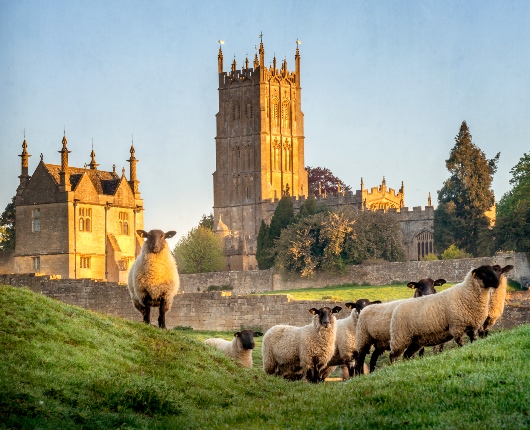
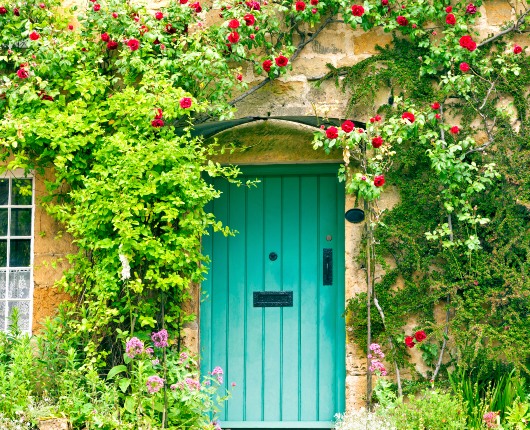
While it’s possible to explore some of the Cotswolds’ prettiest villages and visit a few attractions within a couple of days, to truly experience all the region has to offer you need at least three and ideally five. That will give you time to soak up the charms of the small villages with their immaculate medieval high streets. Some date as far back as the 12th century when the region was renowned throughout Europe for its cotton and wool, with lots of fascinating history to discover. Many have museums for learning more about the area’s past, but the best way to enjoy them is to take your time, simply wandering around, popping into tea rooms, shops, and pubs along the way.
How to Get Around the Cotswolds
The most convenient way to get around the Cotswolds is by car. The roads are fun to drive and a great way to discover hidden delights with something to see around nearly every corner. You can stop as you wish, spending as much time as you’d like in places that interest you most. But it’s also possible to explore on an England private tour. With someone else doing the driving, you can enjoy the scenery without having to focus on the road. Public transport is an option with buses to many villages from the main regional bus stations in Gloucester, Cheltenham, and Stroud. Those up for an adventure might walk The Cotswold Way, a 102-mile-long route from Chipping Campden to Bath.
Best Time to Visit the Cotswolds
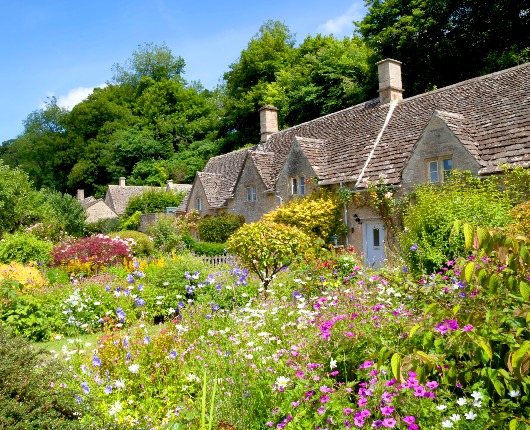
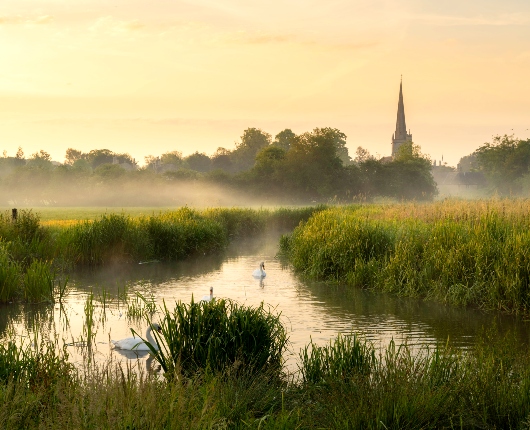
The best time to visit the Cotswolds depends on your interests, tolerance for crowds, and your budget. While summer brings the warmest weather, it’s also the most expensive with hotels and B&Bs charging their highest rates. The area will be at its busiest too, with thick tourist crowds. The spring and fall can be good alternatives as shoulder seasons, with April through early June and mid-September through October not as crowded yet still decent in terms of weather with sunny skies in between cloudy and rainy days. The off-season is the most quiet of all, other than around the Christmas holidays. You’ll also find the biggest discounts on accommodation. The downside is that it will be cool and frequently wet.
Best Villages to Visit in the Cotswolds
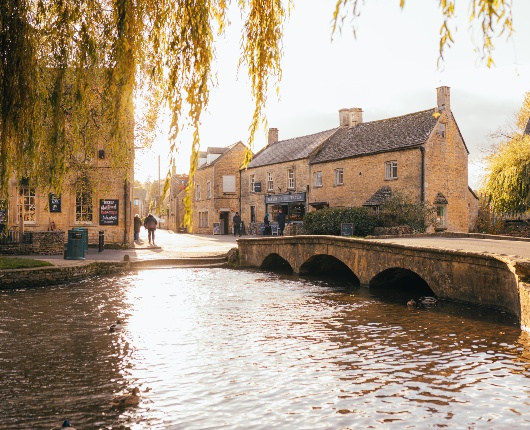
Bourton-on-the-Water
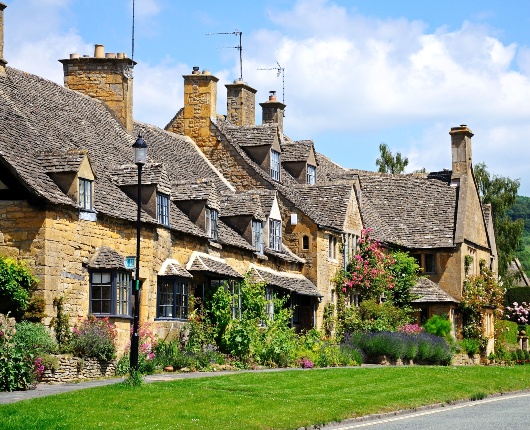
Broadway
Broadway
Broadway is tucked beneath Fish Hill in the far southeast of Worcestershire near the Gloucestershire border. One of the famous places of beauty in the Cotswolds, it’s dominated by a wide, chestnut tree-lined street. Visitors can explore independent shops, enjoy top-notch dining, and perhaps stay at a historic hotel like the former manor house now the Lygon Arms which has played host to Oliver Cromwell and Charles. There’s a mix of period homes and honey-hued Cotswold stone cottages, while attractions include the Broadway Museum and Art Gallery where you can learn more about the village’s history and its cultural heritage and the iconic Broadway Tower, providing a spectacular viewpoint. With the Cotswold Way trail running through, it’s easy to access as well.
Bourton-on-the-Water
“The Venice of the Cotswolds,” Bourton-on-the-Water boasts a romantic setting, centered around a stretch of the River Windrush with many 18th-century stone bridges crossing over. On both sides, there are traditional cottages housing antique shops and other stores selling gifts and souvenirs, art galleries, bakeries, cafes, and pubs. In the summer, the locals follow the centuries-old tradition, playing a game of river football on the shallow stretch of water running through the village’s heart. Among the visitor attractions is the Cotswold Motoring Museum and Toy Collection with rare vehicles and classic cars, the Dragonfly Maze, and the historic St. Lawrence Church, built in the 14th century at Lansdowne and High Street where there has been a church since the early 8th century.
Upper & Lower Slaughter
Lower Slaughter is renowned for its traditional Cotswold-style cottages with its name derived from the Old English term for a “wet land” slough that it sits upon. Built along both banks of the River Eye, the gentle stream also flows through its twin village of Upper Slaughter and is crossed by two footbridges. A 19th-century water mill lies at the village’s west end and was built using red brick although most homes and buildings in the village were constructed using Cotswold stone. Copse Hill Road which was named Britain’s most romantic street can be found here as well. Upper Slaughter was also built along the grassy banks of the River Eye, with Eyford House a highlight, once voted “England’s Favorite House.”
Chipping Campden
One of the most popular villages in the Cotswolds, Chipping Campden boasts the country’s second highest density of grade-listed buildings with the typical Cotswolds stone cottages lining the streets. You’ll find plenty of enticing shops and tearooms while the 17th-century Market Hall and its picturesque arches in the center of High Street make it easy to imagine life. As you walk the ancient stone-paved floor, you can practically hear the echoes of traders’ shouts to the townsfolk who would trade items like poultry, butter, and cheese. Kiftsgate Court is a must-visit with its gardens providing scenic views across the Cotswolds, with the quintessentially English interiors lovely to explore. Other highlights include the Woolstaplers Museum, the Almshouses, and St. James Church.
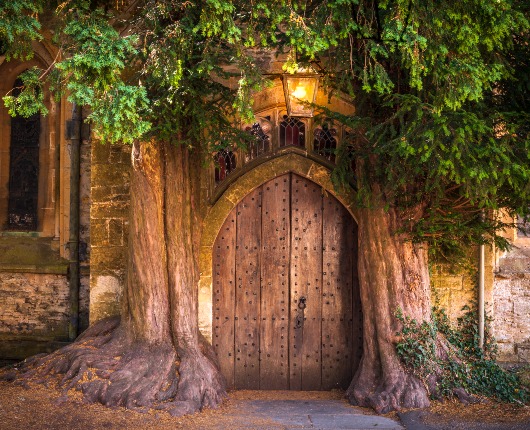
Stow-on-the-Wold
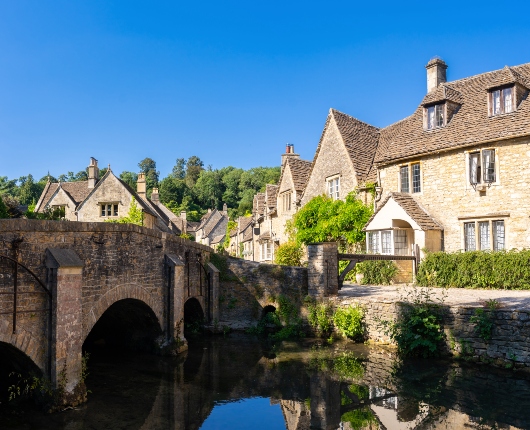
Castle Combe
Burford
One of England’s prettiest villages, medieval Burford is often referred to as the “Gateway to the Cotswolds, located in the West Oxfordshire district about 20 miles west of Oxford close to the border of Gloucestershire. It lies along the River Windrush and became quite prosperous thanks to its wool and quarrying. It not only hosts charming thatched-roof cottages, but it’s filled with unique boutiques, antique shops, and cafes. Little has changed here since Georgian times when it was an important coach stop between the city of Oxford and the West, with its impressive High Street one of the finest in the region. At the Tolsey Museum, set within the Tudor Market/courthouse, visitors can learn more about Burford’s working and social culture.
Stow-on-the-Wold
Located in Gloucestershire along the ancient Roman Fosse Way atop an 800-foot hill, Stow-on-the-Wold is the highest of the Cotswold villages. A historic wool town founded by Norman lords, the Market Square has been the heart of community life here for centuries. It’s been hosting regular markets since the early 12th century and is surrounded by many 16th-century Cotswold stone buildings that now house antique stores, independent shops, art galleries, cafes, and traditional inns. The 15th-century Crooked House and 13th-century St. Edward’s Church are highlights – the church’s wooden door looks like something that came straight from a fairytale. Many believe it inspired the “Doors of Durin” in The Lord of the Rings: The Fellowship of the Ring.
Painswick
“The Queen of the Cotswolds” as it’s often called, Painswick is a historic wool town, one of the region’s most well-preserved while surrounded by some of the most serene countryside. Its streets are a testament to architectural beauty with landmarks like the 18th century Painswick House, especially notable for its Rococo Gardens. Designed in the 1740s, it’s the perfect place to immerse yourself in nature and enjoy magnificent views of the Cotswold countryside. New Street is home to the oldest post office in England which lies adjacent to the country’s oldest bowling green. The parish church of St. Mary is lovely, surrounded by 99 yew trees. Walking and cycling routes explore the town’s surroundings to discover more historic sites and incredible views.
Castle Combe
One of the most photogenic Cotswolds villages, Castle Combe is located in the county of Wiltshire. Its good looks have made it a popular filming location, used in everything from the original “Dr. Doolittle” and TV’s “Downton Abbey” to Stephen Spielberg’s “War Horse.” The homes and buildings are all made from Cotswold stone. No new buildings have been constructed here since the 17th century in order to maintain its idyllic appearance. Some of the highlights include the 13th-century St. Andrew’s Church with its faceless clock said to be one of the oldest still working clocks in England. By strolling the narrow streets to the bridge you’ll enjoy picturesque views and the chance to buy flowers and homemade cakes right from the locals’ houses.
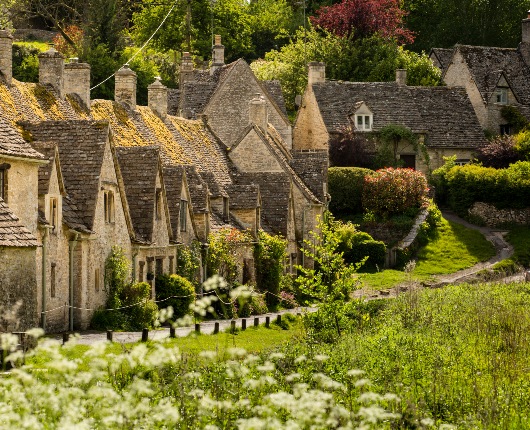
Bibury
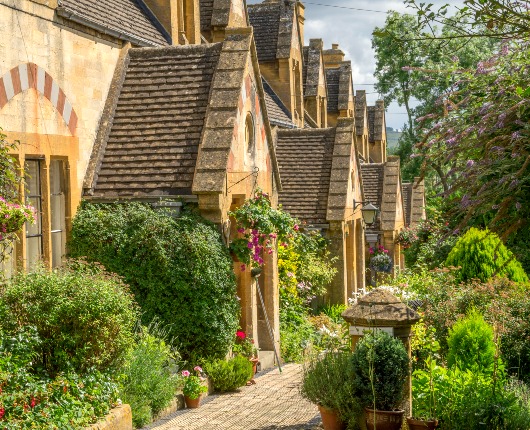
Winchcombe
Bibury
Located along the River Coln in Gloucestershire, charming Bibury is a typical Cotswold village often named among England’s most beautiful. Its stone buildings are lined along the banks of the river while Arlington Row, is one of the country’s most iconic places, appearing on the inside cover of UK passports. It dates to the 14th century when it was built as a monastic wool store before being transformed into cottages for the many weavers who worked here in the 17th century. It also made an appearance in the 2007 film “Stardust,” although most of the movie was shot in Castle Combe. St. Mary’s Church is a highlight from the 11th century, with architectural features from later years, including an intricately carved Norman doorway.
Stanton
The unspoiled village of Stanton is another one of the most beautiful in the Cotswolds, built almost entirely of Cotswold stone. Located about 17 miles from Cheltenham, it’s off the beaten path for most tourists so it tends to be less crowded than popular villages like Bibury and Bourton-on-the-Water. Several of the stone cottages have thatched roofs and there are a number of historic buildings to explore, like the medieval Church of St. Michael and All Angels and Stanton Court, a Jacobean manor house built in the Elizabethan style in the 17th century. From Mount Inn, you’ll enjoy unrivaled views of the area and there are many opportunities for hiking and biking with scenic trails providing more impressive Cotswolds views.
Slad
Slad is a charming village tucked into the heart of the Cotswolds in a lush, hidden valley near Stroud and Painswick. It’s best known for its beautiful views of the Cotswold countryside as well as its link to English author Laura Lee who immortalized it in the 1959 classic, Cider with Rosie. The hamlet has remained mostly unchanged since it was written, with many visitors coming to walk the Laurie Lee Wildlife Way. A five-mile circular trail covering much of the valley, it passes lush slopes, crosses small rivers, and streams, and brings opportunities to spot colorful wildflowers like bluebells and white helleborine in the spring. The village itself includes highlights like the old school house and Holy Trinity Church.
Northleach
While it sits at the center of the Cotswolds, Northleach has remained a best-kept secret. Located in the valley of the River Leach in Gloucestershire, this small, welcoming town is tucked quietly away from the busy A40 road. Here you’ll discover the ancient Market Place with half-timbered homes and buildings dating to the 15th and 16th centuries. It’s also home to one of the most impressive “wool” churches, with the church of St. Peter and St. Paul known as the “Cathedral of the Cotswolds. A short walk away is the 18th-century Old Prison. There are no more convicts here, instead, you’ll find the Cotswold Conservation Board offices, a cafe, and the collection of old farm courts that sits behind it.
Winchcombe
Tucked into a valley about mid-way between Cheltenham and Broadway, the name Winchcombe means “valley with a bend.” It still has the street that curves gracefully along the “combe,” with a timeless quality where black and white half-timbered buildings stand alongside Cotswold stone cottages. There are narrow alleyways to get lost in along with independent shops, antique stores, clothing boutiques, art galleries, historic pubs, and cafes. It’s a particularly popular spot for walking, with a “Walkers are Welcome status,” offering a variety of routes of various lengths to suit all abilities. Cycling and horse riding are popular too. Admire the 15th-century St. Peter’s Church and learn more about the town’s history through the hundreds of artifacts displayed at Winchcombe Museum.
Top Attractions in the Cotswolds
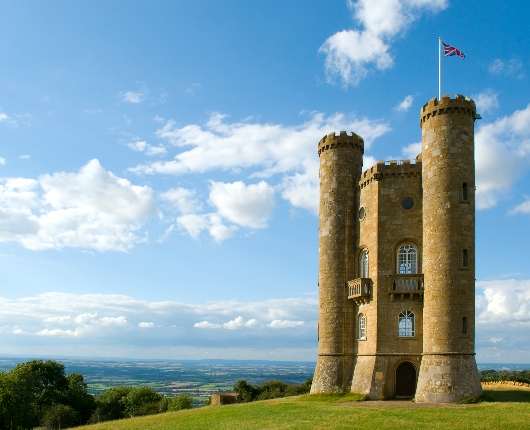
Broadway Tower
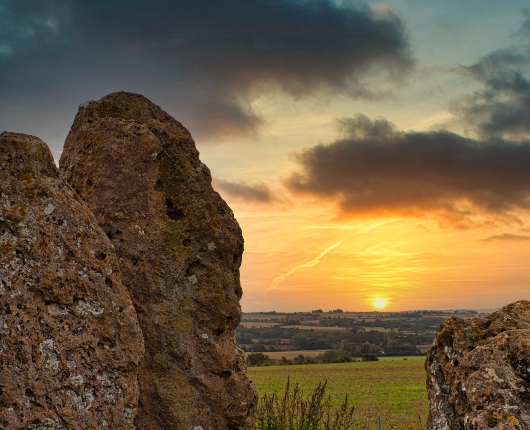
The Rollright Stones
The Rollright Stones
A complex of megalithic monuments, the Rollright Stones are located near the village of Long Compton near the borders of Oxfordshire and Warwickshire at the edge of the Cotswolds. Spanning nearly 2,000 years of Neolithic and Bronze Age development, the oldest is the Whispering Knights dolmen from the early Neolithic period (3,800 to 3,500 BC). Others include the late Neolithic King’s Men stone circle and the King Stone from the early to middle Bronze Age. The stones have an atmosphere of mystery, connected to a vast collection of myths, folklore, and tales of strange happenings. Natural Jurassic limestone boulders like these are found throughout the Cotswold hills, with the stone used to build everything from walls to churches.
Painswick Rococo Garden
The only complete surviving rococo garden in the UK, the Painswick Rococo Garden can be visited in the village of Painswick. It’s become famous for its snowdrops that can be seen in early spring but it’s worth a visit all year long. In April you’ll see colorful tulips, cowslips, and bluebells while May brings alliums and foxgloves and the lavender will be blooming in June. Enjoy the peak of autumn’s foliage in late September and October. Designed in the 1740s as a pleasure garden, it’s laid out around the historic Painswick House and offers beautifully framed views of the Cotswolds. Some of the top spots include the Eagle House where you can sit in the Doric Seat. An on-site cafe offers delicious homemade dishes.
Broadway Tower
Located just outside of Broadway village, the 65-foot Broadway Tower is an iconic landmark that can be climbed for a bird’s-eye view from 1204 feet in elevation. It has an interesting history dating back over 200 years as the brainchild of 18th-century landscape designer Capability Brown, with the help of renowned architect James Wyatt. Construction was completed in 1798 with the site chosen for its dramatic outlook on a pre-medieval trading route. Wyatt designed the tower as an amalgamation of architectural elements, including gargoyles, turrets, balconies, and battlements. It sits within a 50-acre estate of parkland where one can watch for red deer, enjoy a glass of wine and a meal at one of two cafes, or even tour a nuclear bunker.
Painswick Beacon
Just over a mile north of Painswick, about a 30-minute walk, you’ll find one of the top spots for a panoramic view of the Cotswolds, Painswick Beacon. Set atop the site of an Iron Age hill fort dating to 400 BC, it rises nearly 930 feet providing a 360-degree vista that stretches as far as the Brecon Beacons and Forest of Dean in one direction and the Malvern Hills in the other. Part of the Cotswolds Commons and Beechwoods Site of Special Scientific Interest thanks to its plant life, in the spring, the grassy grounds that surround it, primarily the western side, are filled with wildflowers, including some rare species like the musk orchid and fly orchid.
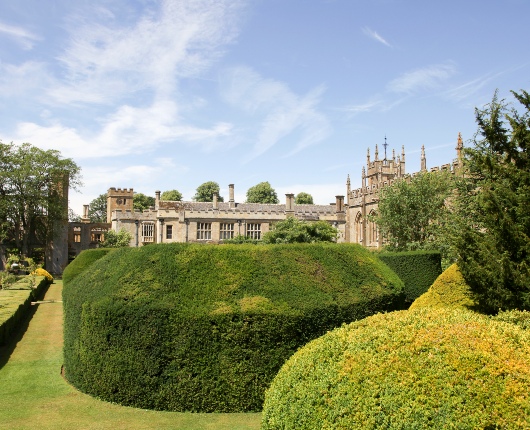
Sudeley Castle
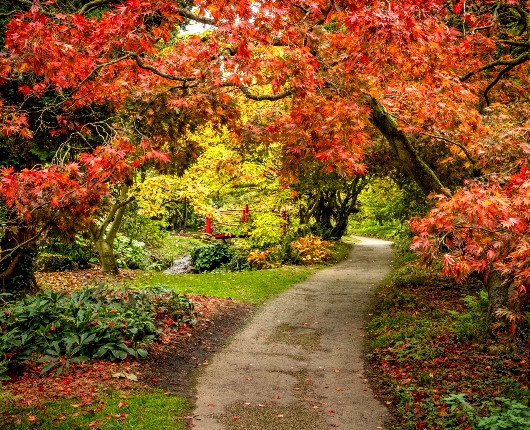
Batsford Arboretum
Sudeley Castle
Sudeley Castle is a historic fortress where one can discover a thousand years of English royalty. The only private castle in the country to have a queen buried within the grounds, the last of Henry VIII’s six wives, Katherine Parr, was entombed here in the 15th-century church. The beautifully restored castle rooms are open to explore on a variety of tours and contain many intriguing treasures from ancient Roman times through today. The 1,200-acre estate is also home to 10 award-winning gardens with the Queen’s Garden its crown jewel. There are also many fun attractions for the whole family, including a wooden fort the kids can climb and the famous Adventure Playground, a castle-themed playground with a zip wire to whiz across.
Chedworth Roman Villa
There are many Roman ruins throughout the Cotswolds though the Chedworth Roman Villa is one of the most elaborate and largest Roman villas found in Britain to date, discovered by accident in the mid-19th century. Founded in 120 AD, it also boasts the latest occupation going beyond the period. A significant building phase of the villa dates from the 5th century following the end of Roman rule in Britain, revealing that the wealthy lifestyles of the Romans continued for at least 50 years longer than was once believed, thanks to the mosaics found in newer rooms. An incredible 22 Roman villas have been found within a 10-mile radius. There are many events staged here that help bring the site to life.
Batsford Arboretum
This 56-acre arboretum at Batsford is just a mile west of the historic market town of Moreton in the heart of the Cotswolds. It was established in 1880 by Bertie Mitford and later his famous granddaughters, the Mitford sisters, took it over. Today, it’s especially popular in late winter when the aconites, snowdrops, and early flowering daffodils burst into life. That’s followed by gorgeous Japanese ornamental cherries, magnolias, fritillaries, and hellebores, the highlights between late March and mid-April. Around the peak of the season, the meadows are filled with colorful wildflowers. There are also some massive North American redwoods. A 1.7-mile path from Moreton will bring you here on foot although it’s also possible to reach from the A44 road.
Snowshill Manor & Garden
Snowshill Manor is a historic manor house that sits at the edge of the village of Snowshill south of Broadway. The 16th-century country horse is best known for its owner Charles Paget Wade, an eccentric Edwardian artist, poet, and architect who purchased it in 1919 when it lay in ruins. He amassed a vast collection of objects, wide-ranging, made up of anything he believed was well-crafted. By the time the manor was donated to the National Trust, his collection included more than 22,000 objects with highlights like mechanical clocks, Samurai armor, model ships, and musical instruments. His donation came with conditions, including that the major would be open to the public.
Top Walks in the Cotswolds
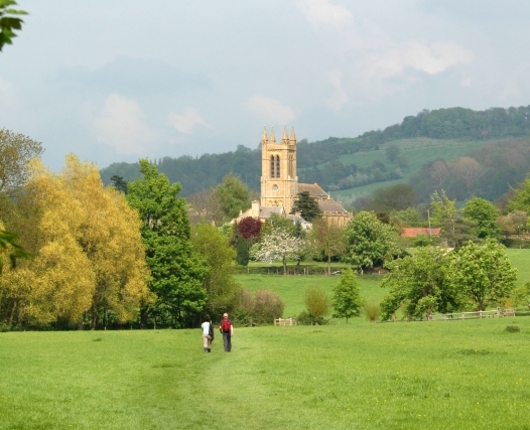
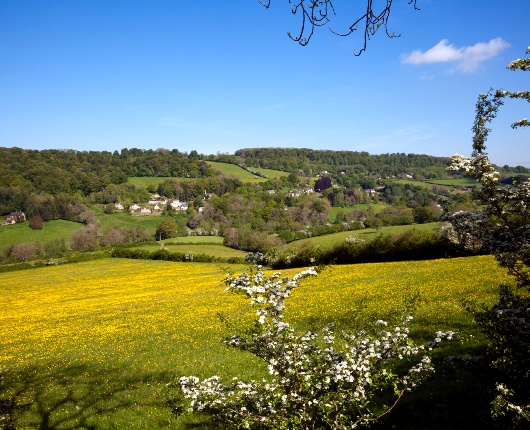
The Cotswold Way
A 102-mile scenic trail running through the Cotswolds from Chipping Campden in the north to Bath in the south, the Cotswold Way can be walked in its entirety which takes six or seven days, or it can be explored in sections. The route follows the western edge of the Cotswolds Hills, passing through beech woodland, rolling pastures, and the honey-hued villages made of Cotswold stone. Neolithic burial barrows, historic battle sites, and other attractions can all be seen as well, while the views are always picturesque but ever-changing. It can be enjoyed in every season although spring, autumn, and winter tend to be the best time for a long walk. Guided walking tours are available that include accommodation along the way.
The Laurie Lee Wildlife Way
The picturesque village of Slad is an ideal base for walking the five-mile circular trail known as Laurie Lee Wildlife Way, named after the English author Laurie Lee who featured it in his best-selling book Cider with Rosie. It links four nature reserves and is dotted with ten poetry posts, each one featuring a poem written by Lee. Enjoy scenic views of the countryside, including lush slopes, rivers, streams, and woodlands. Watch for the rare breed cattle and the 14 different species of orchids on Swift’s Hill that can be seen in the summer. The grasslands are filled with wildflowers, including scabious and harebells, that burst into bloom in late spring and summer. In autumn, you’ll see the brilliant changing of leaves.
The Windrush Way
Covering 13.5 miles from Winchcombe to Bourton-on-the-Water, the Windrush Way is one of the most remote hikes in the Cotswolds. Taking about six hours to complete depending on your pace and stops, it travels over the hills with only the remains of some “lost” medieval villages. That means you’ll need to pack all the water and food that you’ll need but it’s worth it to be immersed in Cotswolds wilderness, complete with colorful wildflowers and tranquil rural farmland. Meandering along the banks of the River Windrush, expect plenty of picturesque views of the countryside and even a castle. The trail passes one of the region’s top attractions, Subtley Castle and its magnificent gardens.
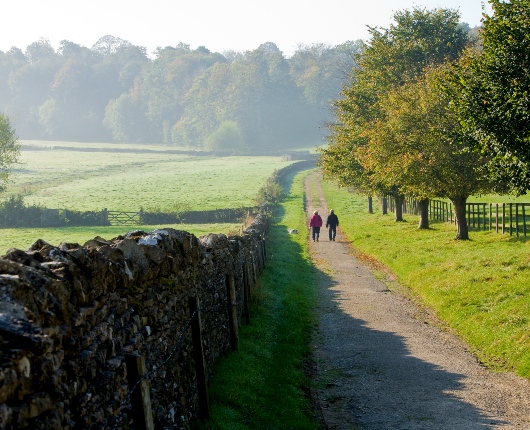
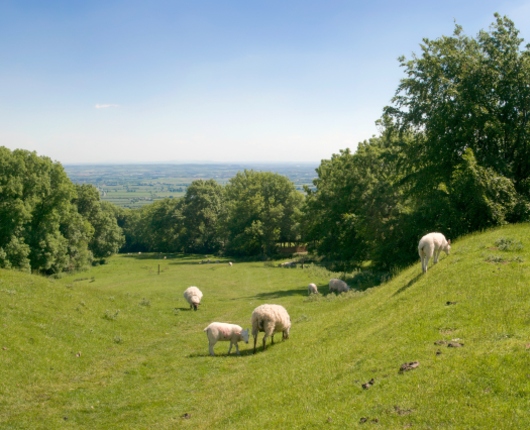
The Diamond Way
Located in the northern Cotswolds, The Diamond Way is named for its roughly diamond-shaped route. This circular trail covers 65 miles, passing through forests, rolling hills, deep valleys, and small villages, starting and ending in Moreton-in-March. It crosses through multiple towns, including some of the best villages in the Cotswolds, Chipping Camden and Bourton-on-the-Water. Wool churches, stately homes, prehistoric hill forts, and burial mounds in between. Along the way, you’ll find pubs that provide the perfect break along with farmhouse B&Bs and market town hotels for overnight stays. While walking the entire route is incredibly rewarding, you can walk any section, creating a circular loop to get you back to the starting point.
The Winchcombe Way
A 42-mile trail centered around the historic town of Winchcombe, Winchcombe Way was designed to showcase the hidden gems of the northern Cotswolds, including ancient sites, historic homes, and beautiful views. Starting from Winchcombe, you’ll see one of the oldest historic monuments in the region, Belas Knap Long Barrow, a fine example of a Neolithic long barrow with side chambers and a false entrance built around 3000 BC. More than 30 Bronze Age skeletons were found inside when it was excavated between 1863 and 1865. Start along Vineyard Street with its row of pretty stone cottages before joining the footpath to Corndean Lane. While climbing uphill if you turn back you’ll see the historic village sprawled below.
Cleeve Common Circular
For a shorter but very rewarding walk with two routes, one four miles and the other six, the Cleeve Common Circular route will bring you over open hilltops, through woodlands, and across streams. Cleve Common is the largest common in the Cotswolds with an area of more than 400 hectares and it includes the highest point in the region at 1,083 feet. It’s renowned for its spectacular views of Cheltenham, the Malverns, the Vale of Evesham, and as far as the Black Mountains in Wales. You’ll be immersed among limestone grassland, with abundant butterflies and wildflowers in addition to enjoying the unrivaled views, making for a big reward for moderate effort with just a few steep sections.
Ready to plan your trip?
What ever you want from your dream trip, our team of
experts are ready to help.
COPYRIGHT © 2024 UNFORGETTABLE TRAVEL. ALL RIGHTS RESERVED





